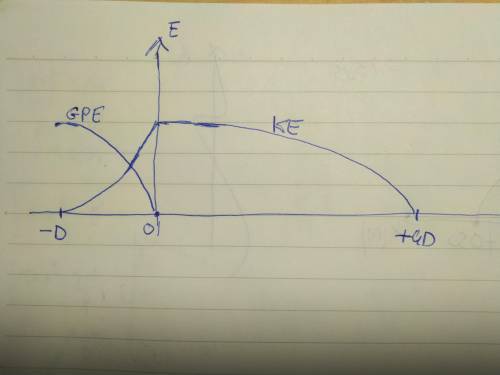
Physics, 22.04.2020 16:51 saintsfan2004
A block is initially at rest on top of an inclined ramp that makes an angle θ0 with the horizontal. The base of the ramp has a length of D . After the block is released from rest, it slides down the ramp onto a rough horizontal surface until it comes to rest at a position x=4D from the base of the ramp, as shown in the figure. There is negligible friction between the block and the inclined ramp, while the coefficient of kinetic friction between the block and the rough horizontal surface is μb .
(a) On the axes below, sketch and label graphs of the following quantities as a function of the position of the block between x=−D and x=4D . Calculations for values for the vertical axis are not necessary, but the same vertical scale should be used for both quantities.
i. The kinetic energy K of the block
ii. The gravitational potential energy Ug of the block-Earth system
(b) The block is released from the top of a new ramp that has a base length of 2D, but still makes an angle θ0 with the horizontal. A student is asked to predict whether the final horizontal position of the block will be twice as far from the base of the ramp compared to when it was released from the original ramp. The student reasons that since the block will be released from a new height that is twice as high as the original height, the block will have more energy when it reaches the base of the ramp, so it will slide farther along the right surface before stopping at a position x=8D.
i. Which aspects of the student’s reasoning, if any, are correct? If no aspect of the student’s reasoning is correct, write “none”.
ii. Which aspects of the student’s reasoning, if any, are incorrect? If no aspect of the student’s reasoning is incorrect, write “none”.
(c) Derive an equation for the new final position of the block. Express your answer in terms of D.
(d) In the following question, refer to the relationships written in part (c), not just the final answer obtained by manipulating those relationships.
For any correct aspects of the student’s reasoning identified in part (b)(i), how is the student’s reasoning expressed by your mathematical relationships in part (c) ?
For any incorrect aspects of the student’s reasoning identified in part (b)(ii), how do your relationships in part (c) correct the student’s incorrect reasoning?

Answers: 1


Another question on Physics

Physics, 22.06.2019 07:30
The slope of a velocity time graph over any interval of time gives the during that interval
Answers: 1

Physics, 22.06.2019 10:00
**urgent** roberto plans to use two transformers to reduce a voltage of 120 v to 4 v. he uses a transformer that has 300 coils in the primary winding and 50 coils in the secondary winding. he has four other transformers, as listed in the table. which transformer should roberto use to have an ending voltage of 4 v? a- w b-xc- yd- z
Answers: 1

Physics, 22.06.2019 14:30
In order to do work, the force vector must be question 1 options: in a different direction than the acceleration vector. in a different direction than the displacement vector. in the same direction as the displacement vector and the motion. in the same direction as the acceleration vector.
Answers: 1

Physics, 22.06.2019 19:30
Point charges q1=+2.00μc and q2=−2.00μc are placed at adjacent corners of a square for which the length of each side is 1.50 cm . point a is at the center of the square, and point b is at the empty corner closest to q2. take the electric potential to be zero at a distance far from both charges. part a what is the electric potential at point a due to q1 and q2? express your answer with the appropriate units.
Answers: 2
You know the right answer?
A block is initially at rest on top of an inclined ramp that makes an angle θ0 with the horizontal....
Questions


Social Studies, 16.10.2020 17:01


Mathematics, 16.10.2020 17:01


History, 16.10.2020 17:01


Mathematics, 16.10.2020 17:01

Mathematics, 16.10.2020 17:01


Physics, 16.10.2020 17:01


Mathematics, 16.10.2020 17:01

Biology, 16.10.2020 17:01

Business, 16.10.2020 17:01


History, 16.10.2020 17:01

Mathematics, 16.10.2020 17:01


Biology, 16.10.2020 17:01







 the initial total energy of the block at the top of the ramp.
the initial total energy of the block at the top of the ramp.
 is the height of the ramp.
is the height of the ramp.


 is the final speed of the block
is the final speed of the block is the acceleration due to friction
is the acceleration due to friction (1)
(1)
 in part a) and
in part a) and  in part b)
in part b)



